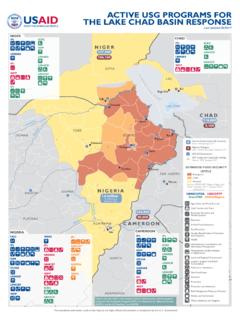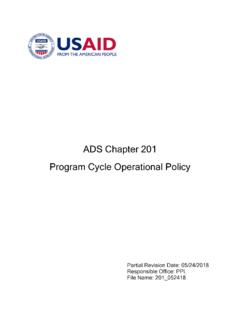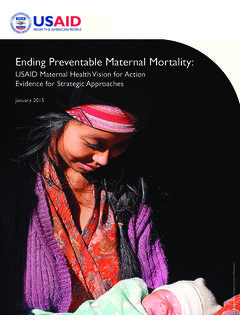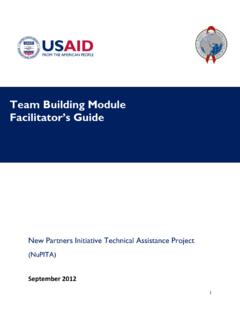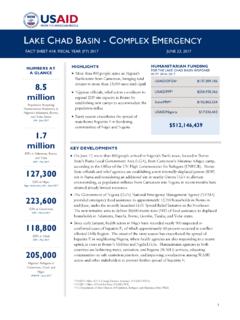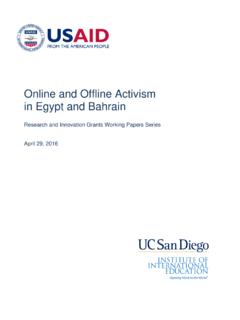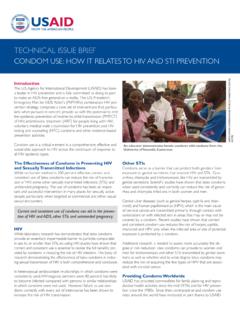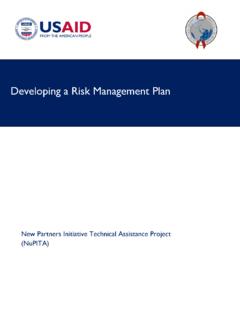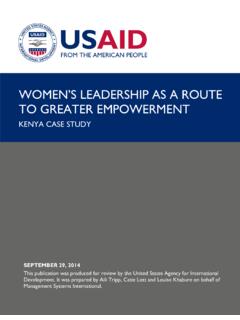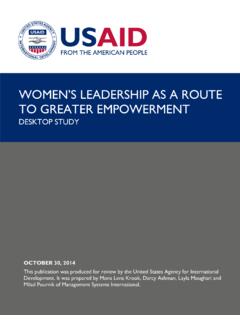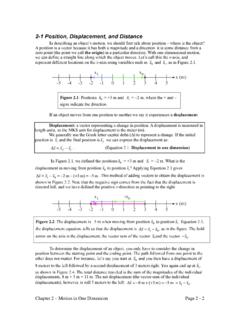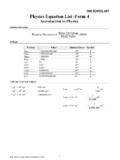Transcription of USAID Climate Strategy 2022-2030
1 NOVEMBER 2021 USAID Climate Strategy 2022-2030 DRAFT for Public ReviewiDraft USAID Climate StrategyUSAID Climate Strategy 2022-2030 Draft for Public ReviewComments will be accepted until November 24, 2021iiDraft USAID Climate StrategyContentsI. INTRODUCTION 1II. OUR TARGETS FOR ACHIEVEMENT: 2022-2030 2 III. STRATEGIC FRAMEWORK 5 STRATEGIC OBJECTIVE 1:FACILITATE TARGETED DIRECT ACTION: ACCELERATE AND SCALE TARGETED Climate ACTIONS 7 STRATEGIC OBJECTIVE 2: DRIVE SYSTEMS change : CATALYZE TRANSFORMATIVESHIFTS TO NET-ZERO AND Climate -RESILIENT PATHWAYS 13 SPECIAL OBJECTIVE: DOING OUR PART:STRENGTHEN OPERATIONS AND APPROACHES TO PROGRAMMING TO ADDRESS Climate change AND FURTHER Climate JUSTICE WITHIN USAID ANDOUR PARTNER ORGANIZATIONS 17IV.
2 ROADMAP TO IMPLEMENTATION 18 ANNEX I: ASSUMPTIONS ON WHICH OUR TARGETS ARE BASED 21 ANNEX II: EVOLVING POLICY CONSIDERATIONS 231 Draft USAID Climate StrategyI. INTRODUCTION Climate change is a planetary crisis that is leaving no corner of the world untouched Failure to aggressively address this crisis will have dire consequences for us all Conversely, responding to the Climate crisis helps avoid these dangerous consequences, and incentivizes economic, technological, ecological, and socio-political innovations in the very systems it threatens Climate change affects the frequency, intensity, and duration of extreme weather events, alters precipitation patterns, disrupts ecological systems, and causes temperatures and sea levels to rise These changes in turn exacerbate economic, socio-cultural, and ecological inequities, and contribute to hunger, poverty, malnutrition, displacement , fragility, and increased mortality Climate change impacts go beyond just the environmental sector to affect human health, nutrition and food security.
3 Ecosystems and biodiversity, peace and stability, and access to essential services, such as health care, water, sanitation and hygiene, and education Climate change threatens to drive increases in maternal and child malnutrition, is an increasing threat to national security, and contributes to migration, displacement and increased pressure on scarce government resources Climate change also exacerbates inequalities, increasing the vulnerability of marginalized and underrepresented populations to gender-based violence, dispossession, and disempowerment 1 The Climate crisis is occurring concurrently with other global crises, including the COVID-19 pandemic, food and water insecurity, accelerated extinctions, and increasing violence and conflict All of these make addressing the Climate crisis more difficult However, concurrent crises may also provide opportunities to leverage resources and political will to achieve the transformative change necessary and envisioned in this Strategy Addressing Climate change is a top priority for USAID as part of the U S Government s renewed and strengthened commitments to building Climate resilience and helping limit warming to 1 5 degrees Celsius as called for under the Paris Agreement At home, the US faces disruption to our food and water supplies and more frequent and severe disasters Around the world, Climate change is threatening U S national interests through greater conflict, migration, and disasters Within the larger U S Government effort, USAID plays a leading international role by working on the ground with partner governments and local actors to strengthen mitigation and adaptation This Climate Strategy , spanning from 2022 to 2030.
4 Represents an effort to align USAID s programs and investments with the significant challenges confronting us while drawing on our strengths as an international development agency, which include our global presence, longevity in many of our partner countries, and breadth of technical and development expertise (see USAID s Strengths graphic) USAID s current approaches to addressing several issues is still evolving in tandem with emerging USG policies, including fossil fuels For more information, see Annex II 1 USAID conducted a detailed gender analysis to inform this Climate USAID Climate StrategyUSAID's StrengthsGlobal PresenceStrong on-the-ground presence globally enables USAID to amplify and build on local priorities in creating sustainable Climate actions that are locally-led and locally valued LongevityLong and consistent history of working with partner countries, organizations, the private sector, and communities situates USAID as a trusted and influential partner Technical ExpertiseUSAID's in-depth sectorial technical expertise combined with contextual understanding of local economic, political, cultural.
5 And institutional landscapes is unsurpassed in the US government USAID will ensure that human rights and equity are woven carefully throughout our efforts to ensure our ambitious Climate actions achieve sustainable impacts II. OUR TARGETS FOR ACHIEVEMENT: 2022-2030 This Strategy sets six high level targets that represent the breadth of achievements USAID aims to generate by 2030: USAID partner countries will reduce, avoid, or sequester six billion metric tons of carbon dioxide equivalent through activities supported by USAID by 2030 USAID will mobilize $150 billion in public and private finance for Climate by 2030 USAID will enable the improved Climate resilience of 500 million people by 2030 In at least 80 partner countries, USAID will align its country programming by 2024 with Nationally Determined Contributions and National Adaptation Plans and priorities, and, with USAID support, at least half of these countries will demonstrate significant and sustained progress toward achieving country commitments by 2030 USAID will support the protection, restoration, or management of 100 million hectares with a Climate mitigation benefit by 2030 USAID will support structural changes that improve participation and leadership for Indigenous Peoples.
6 Local communities, women and youth in Climate action in at least 40 partner countries by 2030 Targets are calculated starting from 2022 and will cover the period 2022 - 2030 Draft targets are in line with requested funding levels and interim targets will also be set and reported, including those to be achieved by January 2025 3 Draft USAID Climate Strategy2022-2030 Climate Strategy Targets(Targets are based on assumptions outlined in Annex I)Mitigation: CO2e reduced6 Billion metric tonsFinance: Public and privatefinance mobilized 15 0 Billion dollarsAdaptation:People supported to be climateresilient 500 Million peopleCountry Support:NDCs/NAPs supported80 Countries supportedLand Use:Hectares protected, restored, or managed100 Million hectaresCriticalPopulationsIncrease engagementand partnerships40 Country partnerships strengthened4 Draft USAID Climate StrategyBuilding on lessons learned from our previous Strategy and over 40 listening sessions with partners and stakeholders from around the world, this Climate Strategy transitions USAID towards a much more holistic and Agency-wide approach This transition requires decreasing emphasis on some interventions while continuing or increasing the emphasis on interventions that can achieve the necessary scale and impact we seek, taking into account the contexts in which we work (see Strategic Shifts graphic) Strategic Shifts: How our approach is changingEmphasizingSystems-level Work; Mobilizing Finance; Private Sector Engagement; Locally-led Action; Governance; Equity and Inclusion; Leverage Non- Climate Funding.
7 Partnerships with Key Populations; Humanitarian, Development & Peace CoherenceContinuingRenewable Energy; Reducing Emissions from Land Use; Government Partnerships; Climate Smart Agriculture; Climate Services; Disaster Risk Reduction; Implementation of Nationally Determined Contributions and National Adaptation PlansDeemphasizingPilot Projects; Greenhouse Gas Inventories; National Determined Contribution Development 201620305 Draft USAID Climate StrategyIII. STRATEGIC FRAMEWORKAs reflected in the most recent Intergovernmental Panel on Climate change report,2 this is a critical moment for setting the global Climate trajectory and ensuring future generations are not subjected to the most devastating effects of Climate change Under this new Strategy , USAID is motivated by a vision of a resilient, prosperous, and equitable world with net-zero emissions. As a step toward that vision, this Strategy will guide USAID s efforts through 2030 to advance equitable and ambitious actions to confront the Climate crisis This goal will be achieved through two Strategic Objectives (SO) that allow USAID to facilitate targeted direct action (SO 1) and drive systems change (SO 2) These two strategic objectives are mutually reinforcing.
8 Many programs and activities will contribute to both, in parallel or sequentially USAID will also demonstrate our commitment to addressing the Climate crisis by transforming the way the Agency operates through a Special Objective (SpO) where USAID commits to doing our part by transforming our own operations to substantially reduce carbon emissions and adapt to the Climate crisis To achieve these strategic objectives, USAID will take an all hands on deck approach, engaging every Bureau and Mission throughout the Agency worldwide to achieve our Climate goals Our success will require harnessing a combination of dedicated Climate and other sectoral funding as we take a holistic approach to Climate change programming, integrating Climate into all areas of our development and humanitarian assistance and expanding definitions of success in all sectors to include Climate goals This will involve not just targeted actions but also the methodical and long-term work of influencing the systems that shape economies and societies Throughout implementation of this Strategy .
9 USAID will consult and partner with those most vulnerable to Climate change , including Indigenous Peoples, women, youth, and marginalized and underrepresented populations, to avoid unintended harm and maximize local benefits Further, five important principles will be embedded into all actions taken under this Strategy as reflected in the graphic below and woven throughout the following pages The dual Climate change priorities of mitigation (reducing emissions) and adaptation (improving resilience to Climate impacts) cut across the strategic objectives and are embedded throughout the framework. Under the first strategic objective, USAID addresses adaptation and mitigation through separate but mutually reinforcing efforts to ensure that the most urgent needs of each priority are met. Under the second strategic objective, USAID will prioritize efforts to transform systems over the long-term in ways that address both adaptation and mitigation needs IPCC, 2021: Climate change 2021: The Physical Science Basis.
10 Contribution of Working Group I to the Sixth Assessment Report of the Intergovernmental Panel on Climate change [Masson-Delmotte, V., P. Zhai, A. Pirani, S. L. Connors, C. P an, S. Berger, N. Caud, Y. Chen, L. Goldfarb, M. I. Gomis, M. Huang, K. Leitzell, E. Lonnoy, J. B. R. Matthews, T. K. Maycock, T. Waterfield, O. Yelek i, R. Yu and B. Zhou (eds.)]. Cambridge University Press. In PressStrategic Framework VISION: A resilient, prosperous, and equitable world with net-zero emissionsGOAL: To advance equitable and ambitious actions to confront the Climate crisisSO 1. FACILITATE TARGETEDDIRECT ACTIONA ccelerate and scale targeted Climate actionsIR Reduce EmissionsCatalyze urgent emissions reductions (mitigation)IR Build ResilienceStrengthen Climate resilience of populations vulnerable to Climate impacts (adaptation)IR Mobilize FinanceIncrease the flow of and equitable access to finance to support adaptation and mitigationIR Partner with IPLCsPartner with Indigenous Peoples and local communities to lead Climate actionsIR Amplify Crucial Voices Enable and empower women and youth - in all their diversity - to lead Climate actionSO 2.
